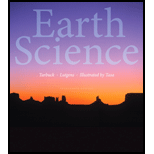
a)
The reason Marquette gets much more snow than Thunder Bay even though both Thunder Bay and Marquette are located on the shore of Lake Superior.
a)
Answer to Problem 1GST
The reason Marquette receives more snow than Thunder Bay is because it is located on the leeward side of the Lake Superior, where continental polar air cools and falls as snow due to the condition known as Lake-effect snowfall.
Explanation of Solution
Lake-effect snow generally occurs in the late fall or early winter, when the dry continental polar air mass moves across a relatively warm Great Lakes waters. The air gains a great deal of heat and moisture by generating humid, unstable air that brings heavy snow to the land, over which the air mass moves next.
In the late autumn and early winter, the continental polar air from Canada blows across Lake Superior and picks up a considerable amount of moisture from the warmer lake waters. The saturated air cools when it hits the leeward shore, (where Marquette is located) and falls as snow in the areas around south and east of Lake Superior. Thunder Bay which is located on the windward shore received much lesser snow for this reason.
b)
The reason for the narrow, north-south zone of relatively heavy snow in the east of Pittsburgh and Charleston though the region is located too far from the Great Lakes to receive lake-effect snowfall and whether the reason explains the shape of this snowy zone.
b)
Answer to Problem 1GST
The east of Pittsburgh and Charleston experiences heavy snow because of the orographic lifting of air along the Appalachian Mountains on the windward side of the slopes.
Explanation of Solution
As the maritime polar air arrives at the western shore of North America, it is often accompanied by low clouds and precipitation. When this air advances inland against the western mountains, the orographic lifting of air produces heavy rain or snow on the windward slopes of the mountains.
The band of heavy snow in the east of Pittsburgh and Charleston is caused by the lifting of air onto the higher Appalachian Mountains. The moist air rises and cools to the dew point as it is forced upward, resulting in an increased snowfall in the higher elevations.
Want to see more full solutions like this?
Chapter 19 Solutions
Earth Science (14th Edition)
 Applications and Investigations in Earth Science ...Earth ScienceISBN:9780134746241Author:Edward J. Tarbuck, Frederick K. Lutgens, Dennis G. TasaPublisher:PEARSON
Applications and Investigations in Earth Science ...Earth ScienceISBN:9780134746241Author:Edward J. Tarbuck, Frederick K. Lutgens, Dennis G. TasaPublisher:PEARSON Exercises for Weather & Climate (9th Edition)Earth ScienceISBN:9780134041360Author:Greg CarbonePublisher:PEARSON
Exercises for Weather & Climate (9th Edition)Earth ScienceISBN:9780134041360Author:Greg CarbonePublisher:PEARSON Environmental ScienceEarth ScienceISBN:9781260153125Author:William P Cunningham Prof., Mary Ann Cunningham ProfessorPublisher:McGraw-Hill Education
Environmental ScienceEarth ScienceISBN:9781260153125Author:William P Cunningham Prof., Mary Ann Cunningham ProfessorPublisher:McGraw-Hill Education Earth Science (15th Edition)Earth ScienceISBN:9780134543536Author:Edward J. Tarbuck, Frederick K. Lutgens, Dennis G. TasaPublisher:PEARSON
Earth Science (15th Edition)Earth ScienceISBN:9780134543536Author:Edward J. Tarbuck, Frederick K. Lutgens, Dennis G. TasaPublisher:PEARSON Environmental Science (MindTap Course List)Earth ScienceISBN:9781337569613Author:G. Tyler Miller, Scott SpoolmanPublisher:Cengage Learning
Environmental Science (MindTap Course List)Earth ScienceISBN:9781337569613Author:G. Tyler Miller, Scott SpoolmanPublisher:Cengage Learning Physical GeologyEarth ScienceISBN:9781259916823Author:Plummer, Charles C., CARLSON, Diane H., Hammersley, LisaPublisher:Mcgraw-hill Education,
Physical GeologyEarth ScienceISBN:9781259916823Author:Plummer, Charles C., CARLSON, Diane H., Hammersley, LisaPublisher:Mcgraw-hill Education,





